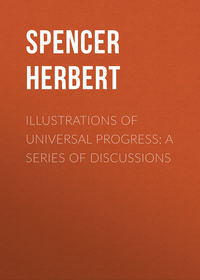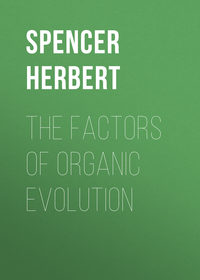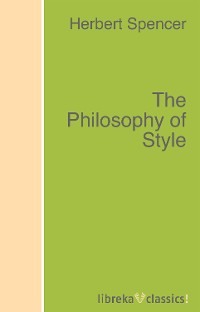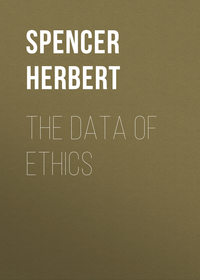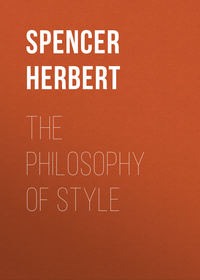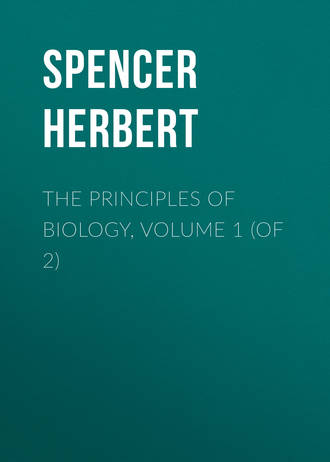 полная версия
полная версияThe Principles of Biology, Volume 1 (of 2)
Not limiting himself to the Darwinian interpretation, however, Professor Weismann says that this degradation may be accounted for by "panmixia alone." Here I will not discuss the adequacy of this supposed cause, but will leave it to be dealt with by implication a few pages in advance, where the general hypothesis of panmixia will be reconsidered.
And now, at length, we are prepared for dealing with Professor Weismann's crucial case – with his alleged disproof that co-adaptation of co-operative parts results from inheritance of acquired characters, because in the case of the Amazon-ants, it has arisen where the inheritance of acquired characters is impossible. For after what has been said, it will be manifest that the whole question is begged when it is assumed that this co-adaptation has arisen since there existed among these ants an organized social state. Unquestionably this organized social state pre-supposes a series of modifications through which it has been reached. It follows, then, that there can be no rational interpretation without a preceding inquiry concerning that earlier state in which there were no castes, but only males and females. What kinds of individuals were the ancestral ants – at first solitary, and then semi-social? They must have had marked powers of offence and defence. Of predacious creatures, it is the more powerful which form societies, not the weaker. Instance human races. Nations originate from the relatively warlike tribes, not from the relatively peaceful tribes. Among the several types of individuals forming the existing ant community, to which, then, did the ancestral ants bear the greatest resemblance? They could not have been like the queens, for these, now devoted to egg-laying, are unfitted for conquest. They could not have been like the inferior class of workers, for these, too, are inadequately armed and lack strength. Hence they must have been most like these Amazon-ants or soldier-ants, which now make predatory excursions – which now do, in fact, what their remote ancestors did. What follows? Their co-adapted parts have not been produced by the selection of variations within the ant-community, such as we now see it. They have been inherited from the pre-social and early social types of ants, in which the co-adaptation of parts had been effected by inheritance of acquired characters. It is not that the soldier-ants have gained these traits; it is that the other castes have lost them. Early arrest of development causes absence of them in the inferior workers; and from the queens they have slowly disappeared by inheritance of the effects of disuse. For, in conformity with ordinary facts of development, we may conclude that in a larva which is being so fed as that the development of the reproductive organs is becoming pronounced, there will simultaneously commence arrest in the development of those organs which are not to be used. There are abundant proofs that along with rapid growth of some organs others abort. And if these inferences are true, then Professor Weismann's argument falls to the ground. Nay, it falls to the ground even if conclusions so definite as these be not insisted upon; for before he can get a basis for his argument he must give good reasons for concluding that these traits of the Amazon-ants have not been inherited from remote ancestors.
One more step remains. Let us grant him his basis, and let us pass from the above negative criticism to a positive criticism. As before, I decline to follow the practice of talking in abstracts instead of in concretes, and contend that, difficult as it may be to see how natural selection has in all cases operated, we ought, at any rate, to trace out its operation whenever we can, and see where the hypothesis lands us. According to Professor Weismann's admission, for production of the Amazon-ant by natural selection, "many parts must have varied simultaneously and in harmony with one another;"125 and he names as such, larger jaws, muscles to move them, larger head, and thicker chitin for it, bigger nerves for the muscles, bigger motor centres in the brain, and, for the support of the big head, strengthening of the thorax, limbs, and skeleton generally. As he admits, all these parts must have varied simultaneously in due proportion to one another. What must have been the proximate causes of their variations? They must have been variations in what he calls the "determinants." He says: —
"We have, however, to deal with the transmission of parts which are variable and this necessitates the assumption that just as many independent and variable parts exist in the germ-plasm as are present in the fully formed organism."126
Consequently to produce simultaneously these many variations of parts, adjusted in their sizes and shapes, there must have simultaneously arisen a set of corresponding variations in the "determinants" composing the germ-plasm. What made them simultaneously vary in the requisite ways? Professor Weismann will not say that there was somewhere a foregone intention. This would imply supernatural agency. He makes no attempt to assign a physical cause for these simultaneous appropriate variations in the determinants: an adequate physical cause being inconceivable. What, then, remains as the only possible interpretation? Nothing but a fortuitous concourse of variations; reminding us of the old "fortuitous concourse of atoms." Nay, indeed, it is the very same thing. For each of the "determinants," made up of "biophors," and these again of protein-molecules, and these again of simpler chemical molecules, must have had its molecular constitution changed in the required way; and the molecular constitutions of all the "determinants," severally modified differently, but in adjustment to one another, must have been thus modified by "a fortuitous concourse of atoms." Now if this is an allowable supposition in respect of the "determinants," and the varying organs arising from them, why is it not an allowable supposition in respect of the organism as a whole? Why not assume "a fortuitous concourse of atoms" in its broad, simple form? Nay, indeed, would not this be much the easier? For observe, this co-adaptation of numerous co-operative parts is not achieved by one set of variations, but is achieved gradually by a series of such sets. That is to say, the "fortuitous concourse of atoms" must have occurred time after time in appropriate ways. We have not one miracle, but a series of miracles!
* * * * *Of the two remaining points in Professor Weismann's first article which demand notice, one concerns his reply to my argument drawn from the distribution of tactual discriminativeness. In what way does he treat this argument? He meets it by an argument derived from hypothetical evidence – not actual evidence. Taking the case of the tongue-tip, I have carefully inquired whether its extreme power of tactual discrimination can give any life-saving advantage in moving about the food during mastication, in detecting foreign bodies in it, or for purposes of speech; and have, I think, shown that the ability to distinguish between points one twenty-fourth of an inch apart is useless for such purposes. Professor Weismann thinks he disposes of this by observing that among the apes the tongue is used as an organ of touch. But surely a counter-argument equivalent in weight to mine should have given a case in which power to discriminate between points one twenty-fourth of an inch apart instead of one-twentieth of an inch apart (a variation of one-sixth) had a life-saving efficacy; or, at any rate, should have suggested such a case. Nothing of the kind is done or even attempted. But now note that his reply, accepted even as it stands, is suicidal. For what has the trusted process of panmixia been doing ever since the human being began to evolve from the ape? Why during thousands of generations has not the nervous structure giving this extreme discriminativeness dwindled away? Even supposing it had been proved of life-saving efficacy to our simian ancestors, it ought, according to Professor Weismann's own hypothesis, to have disappeared in us. Either there was none of the assumed special capacity in the ape's tongue, in which case his reply fails, or panmixia has not operated, in which case his theory of degeneracy fails.
All this, however, is but preface to the chief answer. The argument drawn from the case of the tongue-tip, with which alone Professor Weismann deals, is but a small part of my argument, the remainder of which he does not attempt to touch – does not even mention. Had I never referred to the tongue-tip at all, the various contrasts in discriminativeness which I have named, between the one extreme of the forefinger-tip and the other extreme of the middle of the back, would have abundantly sufficed to establish my case – would have sufficed to show the inadequacy of natural selection as a key and the adequacy of the inheritance of acquired characters.
It seems to me, then, that judgment must go against him by default. Practically he leaves the matter standing just where it did.127
The other remaining point concerns the vexed question of panmixia. Confirming the statement of Dr. Romanes, Professor Weismann says that I have misunderstood him. Already (Contemporary Review, May, 1893, p. 758, and Reprint, p. 66) I have quoted passages which appeared to justify my interpretation, arrived at after much seeking.128 Already, too, in this review (July, 1893, p. 54) I have said why I did not hit upon the interpretation now said to be the true one: I never supposed that any one would assume, without assigned cause, that (apart from the excluded influence of disuse) the minus variations of a disused organ are greater than the plus variations. This was a tacit challenge to produce reasons for the assumption. Professor Weismann does not accept the challenge, but simply says: – "In my opinion all organs are maintained at the height of their development only through uninterrupted selection" (p. 332): in the absence of which they decline. Now it is doubtless true that as a naturalist he may claim for his "opinion" a relatively great weight. Still, in pursuance of the methods of science, it seems to me that something more than an opinion is required as the basis of a far-reaching theory.129
Though the counter-opinion of one who is not a naturalist (as Professor Weismann points out) may be of relatively small value, yet I must here again give it, along with a final reason for it. And this reason shall be exhibited, not in a qualitative form, but in a quantitative form. Let us quantify the terms of the hypothesis by weights; and let us take as our test case the rudimentary hind-limbs of the whale. Zoologists are agreed that the whale has been evolved from a mammal which took to aquatic habits, and that its disused hind-limbs have gradually disappeared. When they ceased to be used in swimming, natural selection played a part – probably an important part – in decreasing them; since, being then impediments to movement through the water, they diminished the attainable speed. It may be, too, that for a period after disappearance of the limbs beneath the skin, survival of the fittest had still some effect. But during the latter stages of the process it had no effect; since the rudiments caused no inconvenience and entailed no appreciable cost. Here, therefore, the cause, if Professor Weismann is right, must have been panmixia. Dr. Struthers, Professor of Anatomy at Aberdeen, whose various publications show him to be a high, if not the highest, authority on the anatomy of these great cetaceans, has kindly taken much trouble in furnishing me with the needful data, based upon direct weighing and measuring and estimation of specific gravity. In the Black Whale (Balænoptera borealis) there are no rudiments of hind-limbs whatever: rudiments of the pelvic bones only remain. A sample of the Greenland Right Whale, estimated to weigh 44,800 lbs., had femurs weighing together 3½ ozs.; while a sample of the Razor-back Whale (Balænoptera musculus), 50 feet long, and estimated to weigh 56,000 lbs., had rudimentary femurs weighing together one ounce; so that these vanishing remnants of hind-limbs weighed but one-896,000th part of the animal. Now in considering the alleged degeneration by panmixia, we have first to ask why these femurs must be supposed to have varied in the direction of decrease rather than in the direction of increase. During its evolution from the original land-mammal, the whale has grown enormously, implying habitual excess of nutrition. Alike in the embryo and in the growing animal, there must have been a chronic plethora. Why, then, should we suppose these rudiments to have become smaller? Why should they not have enlarged by deposit in them of superfluous materials? But let us grant the unwarranted assumption of predominant minus variations. Let us say that the last variation was a reduction of one-half – that in some individuals the joint weight of the femurs was suddenly reduced from two ounces to one ounce – a reduction of one-900,000th of the creature's weight. By inter-crossing with those inheriting the variation, the reduction, or a part of the reduction, was made a trait of the species. Now, in the first place, a necessary implication is that this minus variation was maintained in posterity. So far from having reason to suppose this, we have reason to suppose the contrary. As before quoted, Mr. Darwin says that "unless carefully preserved by man," "any particular variation would generally be lost by crossing, reversion, and the accidental destruction of the varying individuals."130 And Mr. Galton, in his essay on "Regression towards Mediocrity,"131 contends that not only do deviations of the whole organism from the mean size tend to thus disappear, but that deviations in its components do so. Hence the chances are against such minus variation being so preserved as to affect the species by panmixia. In the second place, supposing it to be preserved, may we reasonably assume that, by inter-crossing, this decrease, amounting to about a millionth part of the creature's weight, will gradually affect the constitutions of all Razor-back Whales distributed over the Arctic seas and the North Atlantic Ocean, from Greenland to the Equator? Is this a credible conclusion? For three reasons, then, the hypothesis must be rejected.
Thus, the only reasonable interpretation is the inheritance of acquired characters. If the effects of use and disuse, which are known causes of change in each individual, influence succeeding individuals – if functionally-produced modifications of structure are transmissible, as well as modifications of structure otherwise arising – then this reduction of the whale's hind limbs to minute rudiments is accounted for. The cause has been unceasingly operative on all individuals of the species ever since the transformation began.
In one case see all. If this cause has thus operated on the limbs of the whale, it has thus operated in all creatures on all parts having active functions.
* * * * *At the outset I intimated that I must limit my replies to those arguments of Professor Weismann which are contained in his first article. That those contained in his second might be dealt with no less effectually, did time and space permit, is manifest to me; but about the probability of this the reader must form his own judgment. My replies thus far may be summed up as follows: —
Professor Weismann says he has disproved the conclusion that degeneration of the little toe has resulted from inheritance of acquired characters. But his reasoning fails against an interpretation he overlooks. A profound modification of the hind limbs and their appendages must have taken place during the transition from arboreal habits to terrestrial habits; and dwindling of the little toe is an obvious consequence of disuse, at the same time that enlargement of the great toe is an obvious consequence of increased use.
The entire argument based on the unlike forms and instincts presented by castes of social insects is invalidated by an omission. Until probable conclusions are reached respecting the characters which such insects brought with them into the organized social state, no valid inferences can be drawn respecting characters developed during that state.
A further large error of interpretation is involved in the assumption that the different caste-characters are transmitted to them in the eggs laid by the mother insect. While we have evidence that the unlike structures of the sexes are determined by nutrition of the germ before egg-laying, we have evidence that the unlike structures of classes are caused by unlikenesses of nutrition of the larvæ. That these varieties of forms do not result from varieties of germ-plasms, is demonstrated by the fact that where there are varieties of germ-plasms, as in varieties of the same species of mammal, no deviations in feeding prevent display of their structural results.
For such caste-modifications as those of the Amazon-ants, which are unable to feed themselves, there is a feasible explanation other than Professor Weismann's. The relation of common ants to their domestic animals – aphides and coccids – which yield them food on solicitation, does not differ widely from this relation between these Amazon-ants and their domestic animals – the slave-ants. And the habit of being fed, contracted during the first stages of their parasitic life, when there were perfect males and females, may, during that stage, have become established by inheritance. Meanwhile the opposed interpretation – that this incapacity has resulted from the selection of those ant-communities the queens of which laid eggs that had so varied as to entail this incapacity – implies that a scarcely appreciable economy of nerve-matter advantaged the stirp so greatly as to cause it to spread more than other stirps: an incredible supposition.
As the outcome of these alternative interpretations we saw that the argument respecting the co-adaptation of co-operative parts, which Professor Weismann thinks is furnished to him by the Amazon-ants, disappears. The ancestral ants were conquering ants. These founded the communities; and hence those members of the present communities which are most like them are the Amazon-ants. If so, the co-adaptation of the co-operative parts was effected by inheritance during the solitary and semi-social stages. Even were there no such solution, the opposed solution will be unacceptable. These simultaneous appropriate variations of the co-operative parts in sizes, shapes, and proportions, are supposed to be effected by simultaneous variations in the "determinants" of the germ-plasms; and in the absence of an assigned physical cause, this implies a fortuitous concourse of appropriate variations, which carries us back to a "fortuitous concourse of atoms." This may just as well be extended to the entire organism. The old hypothesis of special creations is more consistent and comprehensible.
To rebut my inference drawn from the distribution of discriminativeness, Professor Weismann uses not an argument but the blank form of an argument. The ability to discriminate one twenty-fourth of an inch by the tongue-tip may have been useful to the ape: no conceivable use being even suggested. And then the great body of my argument derived from the distribution of discriminativeness over the skin, which amply suffices, is wholly ignored.
The tacit challenge I gave to name some facts in support of the hypothesis of panmixia – or even a solitary fact – is passed by. It remains a pure speculation having no basis but Professor Weismann's "opinion." When from the abstract statement of it we pass to a concrete test, in the case of the whale, we find that it necessitates an unproved and improbable assumption respecting plus and minus variations; that it ignores the unceasing tendency to reversion; and that it implies an effect out of all proportion to the cause.
It is curious what entirely opposite conclusions men may draw from the same evidence. Professor Weismann thinks he has shown that the "last bulwark of the Lamarckian principle is untenable." Most readers will hold with me that he is, to use the mildest word, premature in so thinking. Contrariwise my impression is that he has not shown either this bulwark or any other bulwark to be untenable; but rather that while his assault has failed it has furnished opportunity for strengthening sundry of the bulwarks.
IVAmong those who follow a controversy to its close, not one in a hundred turns back to its beginning to see whether its chief theses have been dealt with. Very often the leading arguments of one disputant, seen by the other to be unanswerable, are quietly ignored, and attention is concentrated on subordinate arguments to which replies, actually or seemingly valid, can be made. The original issue is thus commonly lost sight of.
More than once I have pointed out that, as influencing men's views about Education, Ethics, Sociology, and Politics, the question whether acquired characters are inherited is the most important question before the scientific world. Hence I cannot allow the discussion with Professor Weismann to end in so futile a way as it will do if no summary of results is made. Here, therefore, I propose to recapitulate the whole case in brief. Primarily my purpose is to recall certain leading propositions which, having been passed by unnoticed, remain outstanding. I will turn, in the second place, to such propositions as have been dealt with; hoping to show that the replies given are invalid, and consequently that these propositions also remain outstanding.
But something beyond a summing-up is intended. A few pages at the close will be devoted to setting forth new evidence which has come to light since the controversy commenced – evidence which many will think sufficient in itself to warrant a positive conclusion.
* * * * *The fact that the tip of the fore finger has thirty times the power of discrimination possessed by the middle of the back, and that various intermediate degrees of discriminative power are possessed by various parts of the skin, was set down as a datum for my first argument. The causes which might be assigned for these remarkable contrasts were carefully examined under all their aspects. I showed in detail that the contrasts could not in any way be accounted for by natural selection. I further showed that no interpretation of them is afforded by the alleged process of panmixia: this has no locus standi in the case. Having proved experimentally, that ability of the fingers to discriminate is increased by practice, and having pointed out that gradations of discriminativeness in different parts correspond with gradations in the activities of the parts as used for tactual exploration, I argued that these contrasts have arisen from the organized and inherited effects of tactual converse with surrounding things, varying in its degrees according to the positions of the parts – in other words, that they are due to the inheritance of acquired characters. As a crowning proof I instanced the case of the tongue-tip, which has twice the discriminativeness of the forefinger-tip: pointing out that consciously, or semi-consciously, or unconsciously, the tongue-tip is perpetually exploring the inner surfaces of the teeth.
Singling out this last case, Professor Weismann made, or rather adopted from Dr. Romanes, what professed to be a reply but was nothing more than the blank form of a reply. It was said that though this extreme discriminativeness of the tongue-tip is of no use to mankind, it may have been of use to certain ancestral primates. No evidence of any such use was given; no imaginable use was assigned. It was simply suggested that there perhaps was a use.
In my rejoinder, after indicating the illusory nature of this proceeding (which is much like offering a cheque on a bank where no assets have been deposited to meet it), I pointed out that had the evidence furnished by the tongue tip never been mentioned, the evidence otherwise furnished amply sufficed. I then drew attention to the fact that this evidence had been passed over, and tacitly inquired why.
No reply.132
* * * * *In his essay on "The All-Sufficiency of Natural Selection," Professor Weismann set out, not by answering one of the arguments I had used, but by importing into the discussion an argument used by another writer, which it was easy to meet. It had been contended that the smallness and deformity of the little toe are consequent upon the effects of boot-pressure, inherited from generation to generation. To this Professor Weismann made the sufficient reply that the fusion of the phalanges and otherwise degraded structure of the little toe, exist among peoples who go barefoot.



